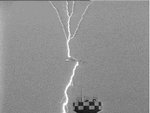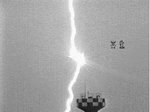Airborne
Banned
Looking at the two photos makes one wonder how the aircraft could possibly survive such a hit. And yet they do. Virtually every day.
The lightning and aircraft story.
Shielding and surge suppressors
Since the outer skin of most airplanes is primarily aluminum, which is a very good conductor of electricity; the secret to safe lightning hits is to allow the current to flow through the skin from the point of impact to some other point without interruption or diversion to the interior of the aircraft.
Estimates show that each commercial airliner averages one lighting hit per year but the last crash that was attributed to lightning was in 1967 when the fuel tank exploded, causing the plane to crash. Generally, the first contact with lightning is at an extremity...the nose or a wingtip. As the plane continues to fly through the areas of opposite charges, the lightning transits through the aircraft skin and exits through another extremity point, frequently the tail
Another related problem with lightning is the effect it can have on computers and flight instruments. Shielding and surge suppressors insure that electrical transients do not threaten the on board avionics and the miles of electrical wiring found in modern aircraft. All components that are vital to the safe operation of commercial aircraft must be certified to meet the stringent regulations of the FAA for planes flying into the United States.
The Static Wick
Most aircraft do not fly into lightning storms, or fly through storms or areas where lightning is likely to be present. What we see as lightning is really a massive flood of electrons seeking equilibrium, either from cloud-cloud or from cloud-ground. In both cases, huge amounts of electric charge build up at the edges of the cloud. The electricity finds it's way from one place to the other via what's called a "step leader".
The sheer power of the cloud will start to attract electrons from the ground. These electrons will gather on anything that gathers charge (like a fence) or sticks up in the air (like a person), or that does both (like a telephone pole). That electric charge will start to work it's way through the air, ionizing it, until the leader working it's way down, and the leader trying to get up finally meet. When they do - there's lightning. An aircraft flying between the highly charged portions of a cloud will act as a conduit for step leaders, being able to produce one in each direction. If either of them meets a leader coming the other way... ZAP.
The way an aircraft tries to dissipate these step leaders is through the use of something called a "static wick". A static wick is a piece of metal connected electrically to the frame of the aircraft, with one or two spikes or needles on the end. It is housed in a fiberglass rod to insulate it from the airplane. Because the spikes concentrate the electric charge around them, and they are connected to the airframe, they allow the airplane to dissipate any static electricity it may build up out into the air. Also - if lightning DOES strike the plane, the chances are that the electricity will go through the dissipator and not through the airplane.
Also check out these losses due to lightning.
Aviation Losses from Lightning Strikes - National Lightning Safety Institute
The lightning and aircraft story.
Shielding and surge suppressors
Since the outer skin of most airplanes is primarily aluminum, which is a very good conductor of electricity; the secret to safe lightning hits is to allow the current to flow through the skin from the point of impact to some other point without interruption or diversion to the interior of the aircraft.
Estimates show that each commercial airliner averages one lighting hit per year but the last crash that was attributed to lightning was in 1967 when the fuel tank exploded, causing the plane to crash. Generally, the first contact with lightning is at an extremity...the nose or a wingtip. As the plane continues to fly through the areas of opposite charges, the lightning transits through the aircraft skin and exits through another extremity point, frequently the tail
Another related problem with lightning is the effect it can have on computers and flight instruments. Shielding and surge suppressors insure that electrical transients do not threaten the on board avionics and the miles of electrical wiring found in modern aircraft. All components that are vital to the safe operation of commercial aircraft must be certified to meet the stringent regulations of the FAA for planes flying into the United States.
The Static Wick
Most aircraft do not fly into lightning storms, or fly through storms or areas where lightning is likely to be present. What we see as lightning is really a massive flood of electrons seeking equilibrium, either from cloud-cloud or from cloud-ground. In both cases, huge amounts of electric charge build up at the edges of the cloud. The electricity finds it's way from one place to the other via what's called a "step leader".
The sheer power of the cloud will start to attract electrons from the ground. These electrons will gather on anything that gathers charge (like a fence) or sticks up in the air (like a person), or that does both (like a telephone pole). That electric charge will start to work it's way through the air, ionizing it, until the leader working it's way down, and the leader trying to get up finally meet. When they do - there's lightning. An aircraft flying between the highly charged portions of a cloud will act as a conduit for step leaders, being able to produce one in each direction. If either of them meets a leader coming the other way... ZAP.
The way an aircraft tries to dissipate these step leaders is through the use of something called a "static wick". A static wick is a piece of metal connected electrically to the frame of the aircraft, with one or two spikes or needles on the end. It is housed in a fiberglass rod to insulate it from the airplane. Because the spikes concentrate the electric charge around them, and they are connected to the airframe, they allow the airplane to dissipate any static electricity it may build up out into the air. Also - if lightning DOES strike the plane, the chances are that the electricity will go through the dissipator and not through the airplane.
Also check out these losses due to lightning.
Aviation Losses from Lightning Strikes - National Lightning Safety Institute


